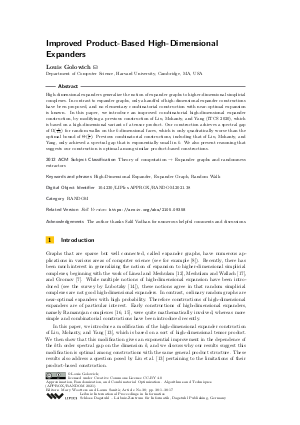Improved Product-Based High-Dimensional Expanders
Author Louis Golowich
-
Part of:
Volume:
Approximation, Randomization, and Combinatorial Optimization. Algorithms and Techniques (APPROX/RANDOM 2021)
Part of: Series: Leibniz International Proceedings in Informatics (LIPIcs)
Part of: Conference: International Conference on Randomization and Computation (RANDOM)
Part of: Conference: International Conference on Approximation Algorithms for Combinatorial Optimization Problems (APPROX) - License:
 Creative Commons Attribution 4.0 International license
Creative Commons Attribution 4.0 International license
- Publication Date: 2021-09-15
File

PDF
LIPIcs.APPROX-RANDOM.2021.38.pdf
- Filesize: 0.69 MB
- 17 pages
Document Identifiers
Related Versions
- Full Version https://arxiv.org/abs/2105.09358
Subject Classification
ACM Subject Classification
- Theory of computation → Expander graphs and randomness extractors
Keywords
- High-Dimensional Expander
- Expander Graph
- Random Walk
Metrics
- Access Statistics
-
Total Accesses (updated on a weekly basis)
0Document
0Metadata
Abstract
High-dimensional expanders generalize the notion of expander graphs to higher-dimensional simplicial complexes. In contrast to expander graphs, only a handful of high-dimensional expander constructions have been proposed, and no elementary combinatorial construction with near-optimal expansion is known. In this paper, we introduce an improved combinatorial high-dimensional expander construction, by modifying a previous construction of Liu, Mohanty, and Yang (ITCS 2020), which is based on a high-dimensional variant of a tensor product. Our construction achieves a spectral gap of Ω(1/(k²)) for random walks on the k-dimensional faces, which is only quadratically worse than the optimal bound of Θ(1/k). Previous combinatorial constructions, including that of Liu, Mohanty, and Yang, only achieved a spectral gap that is exponentially small in k. We also present reasoning that suggests our construction is optimal among similar product-based constructions.
Cite As Get BibTex
Louis Golowich. Improved Product-Based High-Dimensional Expanders. In Approximation, Randomization, and Combinatorial Optimization. Algorithms and Techniques (APPROX/RANDOM 2021). Leibniz International Proceedings in Informatics (LIPIcs), Volume 207, pp. 38:1-38:17, Schloss Dagstuhl – Leibniz-Zentrum für Informatik (2021)
https://doi.org/10.4230/LIPIcs.APPROX/RANDOM.2021.38
BibTex
@InProceedings{golowich:LIPIcs.APPROX/RANDOM.2021.38,
author = {Golowich, Louis},
title = {{Improved Product-Based High-Dimensional Expanders}},
booktitle = {Approximation, Randomization, and Combinatorial Optimization. Algorithms and Techniques (APPROX/RANDOM 2021)},
pages = {38:1--38:17},
series = {Leibniz International Proceedings in Informatics (LIPIcs)},
ISBN = {978-3-95977-207-5},
ISSN = {1868-8969},
year = {2021},
volume = {207},
editor = {Wootters, Mary and Sanit\`{a}, Laura},
publisher = {Schloss Dagstuhl -- Leibniz-Zentrum f{\"u}r Informatik},
address = {Dagstuhl, Germany},
URL = {https://drops.dagstuhl.de/entities/document/10.4230/LIPIcs.APPROX/RANDOM.2021.38},
URN = {urn:nbn:de:0030-drops-147319},
doi = {10.4230/LIPIcs.APPROX/RANDOM.2021.38},
annote = {Keywords: High-Dimensional Expander, Expander Graph, Random Walk}
}
Author Details
Acknowledgements
The author thanks Salil Vadhan for numerous helpful comments and discussions.
References
- Vedat Levi Alev and Lap Chi Lau. Improved analysis of higher order random walks and applications. In Proceedings of the 52nd Annual ACM SIGACT Symposium on Theory of Computing, STOC 2020, pages 1198-1211, New York, NY, USA, 2020. Association for Computing Machinery. URL: https://doi.org/10.1145/3357713.3384317.
- Michael Chapman, Nati Linial, and Yuval Peled. Expander Graphs — Both Local and Global. Combinatorica, 40(4):473-509, August 2020. URL: https://doi.org/10.1007/s00493-019-4127-8.
- David Conlon. Hypergraph expanders from Cayley graphs. Israel Journal of Mathematics, 233(1):49-65, 2019. URL: https://doi.org/10.1007/s11856-019-1895-1.
- David Conlon, Jonathan Tidor, and Yufei Zhao. Hypergraph expanders of all uniformities from Cayley graphs. Proceedings of the London Mathematical Society, 121(5):1311-1336, 2020. URL: https://doi.org/10.1112/plms.12371.
- I. Dinur and T. Kaufman. High Dimensional Expanders Imply Agreement Expanders. In 2017 IEEE 58th Annual Symposium on Foundations of Computer Science (FOCS), pages 974-985, 2017. ISSN: 0272-5428. URL: https://doi.org/10.1109/FOCS.2017.94.
- Ehud Friedgut and Yonatan Iluz. Hyper-regular graphs and high dimensional expanders. arXiv:2010.03829 [math], October 2020. arXiv: 2010.03829. URL: http://arxiv.org/abs/2010.03829.
- Mikhail Gromov. Singularities, Expanders and Topology of Maps. Part 2: from Combinatorics to Topology Via Algebraic Isoperimetry. Geometric and Functional Analysis, 20(2):416-526, August 2010. URL: https://doi.org/10.1007/s00039-010-0073-8.
- Shlomo Hoory, Nathan Linial, and Avi Wigderson. Expander graphs and their applications. Bulletin of the American Mathematical Society, 43(4):439-561, 2006. URL: https://doi.org/10.1090/S0273-0979-06-01126-8.
- Tali Kaufman and David Mass. High Dimensional Random Walks and Colorful Expansion. In 8th Innovations in Theoretical Computer Science Conference (ITCS 2017), volume 67 of Leibniz International Proceedings in Informatics (LIPIcs), pages 4:1-4:27, Dagstuhl, Germany, 2017. Schloss Dagstuhl–Leibniz-Zentrum fuer Informatik. URL: https://doi.org/10.4230/LIPIcs.ITCS.2017.4.
- Tali Kaufman and Izhar Oppenheim. High Order Random Walks: Beyond Spectral Gap. In Approximation, Randomization, and Combinatorial Optimization. Algorithms and Techniques (APPROX/RANDOM 2018), volume 116 of Leibniz International Proceedings in Informatics (LIPIcs), pages 47:1-47:17, Dagstuhl, Germany, 2018. Schloss Dagstuhl–Leibniz-Zentrum fuer Informatik. URL: https://doi.org/10.4230/LIPIcs.APPROX-RANDOM.2018.47.
- Tali Kaufman and Izhar Oppenheim. High dimensional expanders and coset geometries. arXiv:1710.05304 [math], 2020. arXiv: 1710.05304 version: 3. URL: http://arxiv.org/abs/1710.05304.
- Nathan Linial and Roy Meshulam. Homological Connectivity Of Random 2-Complexes. Combinatorica, 26(4):475-487, August 2006. URL: https://doi.org/10.1007/s00493-006-0027-9.
- Siqi Liu, Sidhanth Mohanty, and Elizabeth Yang. High-Dimensional Expanders from Expanders. In 11th Innovations in Theoretical Computer Science Conference (ITCS 2020), volume 151 of Leibniz International Proceedings in Informatics (LIPIcs), pages 12:1-12:32, Dagstuhl, Germany, 2020. Schloss Dagstuhl–Leibniz-Zentrum fuer Informatik. URL: https://doi.org/10.4230/LIPIcs.ITCS.2020.12.
- Alexander Lubotzky. High Dimensional Expanders. In Proceedings of the International Congress of Mathematicians (ICM 2018), pages 705-730. World Scientific, June 2018. URL: https://doi.org/10.1142/9789813272880_0027.
- Alexander Lubotzky, Beth Samuels, and Uzi Vishne. Explicit constructions of Ramanujan complexes of type Ã_d. European Journal of Combinatorics, 26(6):965-993, August 2005. URL: https://doi.org/10.1016/j.ejc.2004.06.007.
- Alexander Lubotzky, Beth Samuels, and Uzi Vishne. Ramanujan complexes of type Ã_d. Israel Journal of Mathematics, 149(1):267-299, December 2005. URL: https://doi.org/10.1007/BF02772543.
- R. Meshulam and N. Wallach. Homological connectivity of random k -dimensional complexes: Homological Connectivity of Random Complexes. Random Structures & Algorithms, 34(3):408-417, May 2009. URL: https://doi.org/10.1002/rsa.20238.
- Izhar Oppenheim. Local Spectral Expansion Approach to High Dimensional Expanders Part I: Descent of Spectral Gaps. Discrete & Computational Geometry, 59(2):293-330, 2018. URL: https://doi.org/10.1007/s00454-017-9948-x.
- Omer Reingold, Salil Vadhan, and Avi Wigderson. Entropy Waves, the Zig-Zag Graph Product, and New Constant-Degree Expanders. The Annals of Mathematics, 155(1):157, January 2002. URL: https://doi.org/10.2307/3062153.
